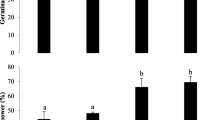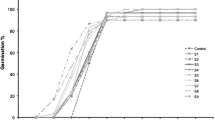Abstract
Soil salinization and alkalization seriously restrict agricultural production. Biofertilizer can alleviate their impact and increase agricultural sustainability. However, the effects of living green microalgae on crop growth under saline-alkali stress are unclear. In this study, the unicellular green microalga Chlorella pyrenoidosa, used as a seed primer and a biofertilizer, was applied to investigate its effects on the growth characteristic of Chenopodium quinoa under artificial saline-alkali conditions (1:1 ratio of NaCl and NaHCO3) and natural saline-alkali soils. The seed primer experiment revealed that saline-alkali stresses inhibited seed germination and decreased seedling vigor index, root length and branch number, shoot length, and fresh weight of C. quinoa. Compared to the control, 25% and 50% doses of C. pyrenoidosa, however, increased the germination of C. quinoa seeds at the stresses of 100 mM and 200 mM saline-alkali concentrations by 29.3% and 12.6%, respectively. A 75% dose of algal cell enhanced the seedling characteristics and alleviated the inhibiting effects of saline-alkali stress on root and shoot length, seedling vigor index, and fresh weight of C. quinoa at 100 mM stress. In the biofertilizer experiment, the growth of C. quinoa was inhibited under saline-alkali soils; algal treatments improved the root length and branch number, shoot length, leaf size, and fresh weight of C. quinoa as well as soil available N, P, and K contents. A comprehensive analysis showed that 100% dose of algae exhibited a lower positive efficiency than 75% dose in the seed experiment. The present study demonstrated that living algal biofertilizer exerted the promoting effects on the germination and plant growth of crops under saline-alkali conditions.








Similar content being viewed by others
Data availability
Not applicable
Code availability
Not applicable
References
Abd El-Baky HH, El-Baz FK, El Baroty GS (2010) Enhancing antioxidant availability in wheat grains from plants grown under seawater stress in response to microalgae extract treatments. Sci Food Agric 90:299–303
Angeli V, Miguel Silva P, Crispim Massuela D, Khan MW, Hamar A, Khajehei F, Graeff-Hönninger S, Piatti C (2020) Quinoa (Chenopodium quinoa Willd.): an overview of the potentials of the “golden grain” and socio-economic and environmental aspects of its cultivation and marketization. Foods 9:216
Barone V, Baglieri A, Stevanato P, Broccanello C, Bertoldo G, Bertaggia M, Cagnin M, Pizzeghello D, Moliterni VMC, Mandolino G, Fornasier F, Squartini A, Nardi S, Concheri G (2018) Root morphological and molecular responses induced by microalgae extracts in sugar beet (Beta vulgaris L.). J Appl Phycol 30:1061–1071
Chen J, Li X, Ye X, Guo P, Hu Z, Qi G, Cui F, Liu S (2021) An S-ribonuclease binding protein EBS1 and brassinolide signaling are specifically required for Arabidopsis tolerance to bicarbonate. J Exp Bot 72:1449–1459
Coppens J, Grunert O, Van Den Hende S, Vanhoutte I, Boon N, Haesaert G, De Gelder L (2016) The use of microalgae as a high-value organic slow-release fertilizer results in tomatoes with increased carotenoid and sugar levels. J Appl Phycol 28:2367–2377
Dineshkumar R, Kumaravel R, Gopalsamy J, Sikder MNA, Sampathkumar P (2018) Microalgae as bio-fertilizers for rice growth and seed yield productivity. Waste Biomass Valor 9:793–800
Garcia-Gonzalez J, Sommerfeld M (2016) Biofertilizer and biostimulant properties of the microalga Acutodesmus dimorphus. J Appl Phycol 28:1051–1061
Gerhardt KE, Gerwing PD, Greenberg BM (2017) Opinion: taking phytoremediation from proven technology to accepted practice. Plant Sci 256:170–185
González A, Castro J, Vera J, Moenne A (2013) Seaweed oligosaccharides stimulate plant growth by enhancing carbon and nitrogen assimilation, basal metabolism, and cell division. J Plant Growth Regul 32:443–448
Guzmán-Murillo MA, Ascencio F, Larrinaga-Mayoral JA (2013) Germination and ROS detoxification in bell pepper (Capsicum annuum L.) under NaCl stress and treatment with microalgae extracts. Protoplasma 250:33–42
Hariadi Y, Marandon K, Tian Y, Jacobsen SE, Shabala S (2011) Ionic and osmotic relations in quinoa (Chenopodium quinoa Willd.) plants grown at various salinity levels. J Exp Bot 62:185–193
Hernández-Carlos B, Gamboa-Angulo MM (2011) Metabolites from freshwater aquatic microalgae and fungi as potential natural pesticides. Phytochem Rev 10:261–286
Jacobsen SE, Mujica A, Jensen CR (2003) The resistance of quinoa (Chenopodium quinoa Willd.) to adverse abiotic factors. Food Rev Int 19:99–109
Liu J, Chen F (2016) Biology and Industrial Applications of Chlorella: advances and Prospects. Adv Biochem Eng Biotechnol 153:1–35
Lu RS (2000) Soil agrochemical analysis method. China Agricultural Science and Technology Press, Beijing
Metting B (1988) Micro-algae in agriculture. In: Borowitzka MA, Borowitzka LJ (eds) Micro-algal biotechnology. Cambridge University Press, Cambridge, pp 288–304
Michalak I, Chojnacka K, Dmytryk A, Wilk R, Gramza M, Rój E (2016) Evaluation of supercritical extracts of algae as biostimulants of plant growth in field trials. Front Plant Sci 7:1591
Rath KM, Rousk J (2015) Salt effects on the soil microbial decomposer community and their role in organic carbon cycling: a review. Soil Biol Biochem 81:108–123
Renuka N, Prasanna R, Sood A, Ahluwalia AS, Bansal R, Babu S, Singh R, Shivay YS, Nain L (2016) Exploring the efficacy of wastewater-grown microalgal biomass as a biofertilizer for wheat. Environ Sci Pollut Res 23:6608–6620
Renuka N, Guldhe A, Prasanna R, Singh P, Bux F (2018) Microalgae as multi-functional options in modern agriculture: current trends, prospects and challenges. Biotechnol Adv 36:1255–1273
Ronga D, Biazzi E, Parati K, Carminati D, Carminati E, Tava A (2019) Microalgal biostimulants and biofertilisers in crop productions. Agronomy 9:192
Ruffino AMC, Rosa M, Hilal M, González JA, Prado FE (2010) The role of cotyledon metabolism in the establishment of quinoa (Chenopodium quinoa) seedlings growing under salinity. Plant Soil 326:213–224
Ruiz-Carrasco K, Antognoni F, Coulibaly AK, Lizardi S, Covarrubias A, Martínez EA, Molina-Montenegro MA, Biondi S, Zurita-Silva A (2011) Variation in salinity tolerance of four lowland genotypes of quinoa (Chenopodium quinoa Willd.) as assessed by growth, physiological traits, and sodium transporter gene expression. Plant Physiol Biochem 49:1333–1341
Shao T, Gu X, Zhu T, Pan X, Zhu Y, Long X, Shao H, Liu M, Rengel Z (2019) Industrial crop Jerusalem artichoke restored coastal saline soil quality by reducing salt and increasing diversity of bacterial community. Appl Soil Ecol 138:195–206
Spolaore P, Joannis-Cassan C, Duran E, Isambert A (2006) Commercial applications of microalgae. J Biosci Bioeng 101:87–96
Stanier RY, Kunisawa R, Mandel M, Cohen-Bazire G (1971) Purification and properties of unicellular blue-green algae (Order Chroococcales). Bacteriol Rev 35:171–205
Tarakhovskaya ER, Maslov YI, Shishova MF (2007) Phytohormones in algae. Russ J Plant Physiol 54:163–170
Tsavkelova EA, Klimova SIu, Cherdyntseva TA, Netrusov AI (2006) Hormones and hormone-like substances of microorganisms: a review. Appl Biochem Microbiol 42:229–235
Uysal O, Uysal FO, Ekinci K (2015) Evaluation of microalgae as microbial fertilizer. Eur J Sustain Dev 4:77–82
Wang W, He H, Zu Y, Guan Y, Liu Z, Zhang Z, Xu H, Yu X (2011) Addition of HPMA affects seed germination, plant growth and properties of heavy saline-alkali soil in northeastern China: comparison with other agents and determination of the mechanism. Plant Soil 339:177–191
Xia J, Ren J, Zhang S, Wang Y, Fang Y (2019) Forest and grass composite patterns improve the soil quality in the coastal saline-alkali land of the Yellow River Delta, China. Geoderma 349:25–35
Xiao R, Zheng Y (2016) Overview of microalgal extracellular polymeric substances (EPS) and their applications. Biotechnol Adv 34:1225–1244
Xu Z, Shao T, Lv Z, Yue Y, Liu A, Long X, Zhou Z, Gao X, Rengel Z (2020) The mechanisms of improving coastal saline soils by planting rice. Sci Total Environ 703:135529
Yang G, Zhao H, Chen Q, Yu X, Li Z, Liu K, Zhang M, Liu Z (2020a) Potassium chloride-modified urea phosphate with response surface optimization and its application effect on maize in saline-alkali soil. ACS Omega 5:17255–17265
Yang Y, Liu L, Singh R, Meng C, Ma S, Jing C, Li Y, Zhang C (2020b) Nodule and root zone microbiota of salt-tolerant wild soybean in coastal sand and saline-alkali soil. Front Microbiol 11:2178
Zhao W, Zhou Q, Tian Z, Cui Y, Liang Y, Wang H (2020) Apply biochar to ameliorate soda saline-alkali land, improve soil function and increase corn nutrient availability in the Songnen Plain. Sci Total Environ 722:137428
Zhang Y, Yang J, Yao R, Wang X, Xie W (2020) Short-term effects of biochar and gypsum on soil hydraulic properties and sodicity in a saline-alkali soil. Pedosphere 30:694–702
Zheng H, Wang X, Chen L, Wang Z, Xia Y, Zhang Y, Wang H, Luo X, Xing B (2018) Enhanced growth of halophyte plants in biochar-amended coastal soil: roles of nutrient availability and rhizosphere microbial modulation. Plant Cell Environ 41:517–532
Zou C, Chen A, Xiao L, Muller HM, Ache P, Haberer G, Zhang M, Jia W, Deng P, Huang R, Lang D, Li F, Zhan D, Wu X, Zhang H, Bohm J, Liu R, Shabala S, Hedrich R, Zhu JK, Zhang H (2017) A high-quality genome assembly of quinoa provides insights into the molecular basis of salt bladder-based salinity tolerance and the exceptional nutritional value. Cell Res 27:1327–1340
Funding
This study was supported by the State Key Laboratory of Integrative Sustainable Dryland Agriculture (in preparation), Shanxi Agricultural University (202105D121008-3–6), National Natural Science Foundation of China (31902394), Key Research and Development Planning Project of Shanxi Province (201803D31063), Applying Basic Research Planning Project of Shanxi Province (201801D221250), Scientific and Technological Innovation Programs of Higher Education Institutions in Shanxi (2021L119), Key Research and Development Planning Project of Jinzhong City (Y192012), Science and Technology Innovation Planning Project of Shanxi Agricultural University (2018YJ16), Outstanding Doctor to Work in Shanxi Province Research Project (SXYBKY2019036), and Specialized Scientific Project of Shanxi Agricultural Valley Construction (SXNGJSKYZX201906).
Author information
Authors and Affiliations
Contributions
Not applicable
Corresponding authors
Ethics declarations
Ethics approval
Not applicable
Consent to participate
Not applicable
Consent for publication
Not applicable
Conflict of interest
The authors declare no competing interests.
Additional information
Publisher's note
Springer Nature remains neutral with regard to jurisdictional claims in published maps and institutional affiliations.
Rights and permissions
About this article
Cite this article
Ma, C., Cui, H., Ren, C. et al. The seed primer and biofertilizer performances of living Chlorella pyrenoidosa on Chenopodium quinoa under saline-alkali condition. J Appl Phycol 34, 1621–1634 (2022). https://doi.org/10.1007/s10811-022-02699-x
Received:
Revised:
Accepted:
Published:
Issue Date:
DOI: https://doi.org/10.1007/s10811-022-02699-x




